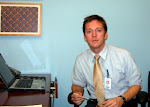www.merrimack.edu/
There are two ends to a stethoscope, and it matters which is which. At least I used to think so.
I once put on a stethoscope with the earpieces turned around (for these two-ended diagnostic tubes are also two-sided). I was a first-year medical student, and there was no reason for me to know better. Still, I recall vividly my feelings of embarrassment and awkward self-awareness after I had unwittingly demonstrated to the patient and mentoring physician in front of me that I had no idea what I was doing.
In well-meaning words with a slightly demeaning tone, the teaching physician explained to me that, because of the anatomy of the human ear, if the earpieces are in backwards, the doctor cannot hear. I believed him at the time, but now I know that he was wrong.
[As those who have read this blog before know, my patients are HIV positive children. Due to the humanity and diligence of scientists and advocates, in recent years, these children have had access to life-saving medicines-so-called ARVs. By some miracle, it is my job to help them take these medicines, and take them appropriately. The result is that, once on ARVs for several months, they are rarely sick. They have HIV but are on the correct and merciful zone of the healty child-to-AIDS spectrum. In other words, when I listen to the hearts and lungs of these children, they are essentially all normal.]
As a pediatrician, I was taught by many men and women in white coats to place the forked end in my ears and to place the end with the bell and circular disk on the patient. Then, yesterday, I began use the patient's end of the stethoscope, and I gave the patient my end. In other words, I asked the kids to listen to my chest.
In doing so, I learned that I can listen...and hear...through both ends of the stethoscope.
To be continued…


